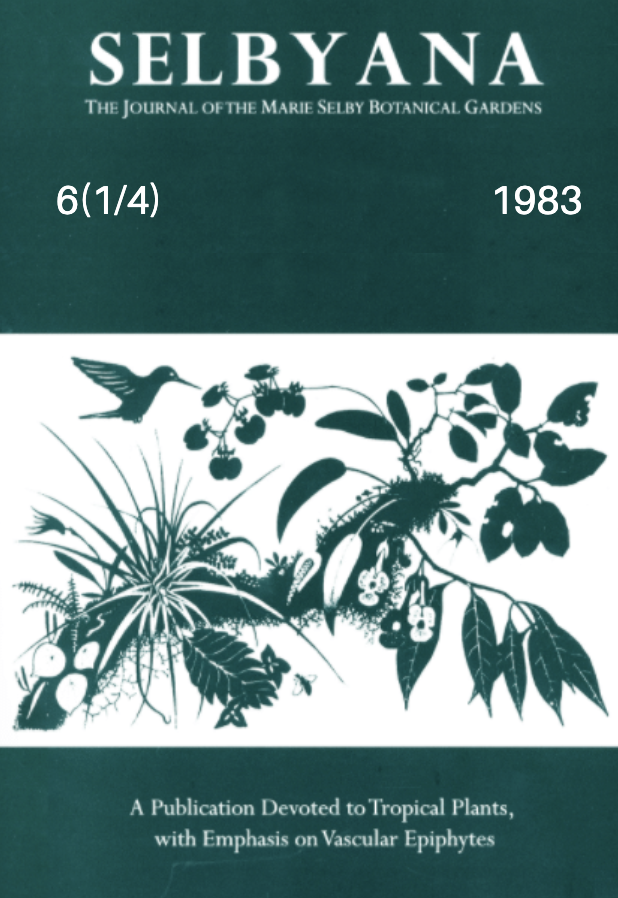Abstract
The seed collection of the species of the Gesneriaceae on which this study is based was obtained, for the most part, during a number of visits to the herbaria of the Smithsonian Institution, Washington, D.C., and the Royal Botanical Garden of Kew, London, and Edinburgh, Scotland. The seed collection comprises well over 800 samples of about 700 species of the Gesneriaceae, representing 113 genera of the 127 in the family, and provides a good taxonomic representation of the Gesneriaceae. Following an examination of all the samples in the seed collection, over 300 species of the 113 genera were selected to represent the wide range of seed morphology characters observed among the examined species of the Gesneriaceae. A system with which to analyze and diagnose seed surface morphology, designed by the author, is based on a format of six major categories and 60 tertiary terms of seed morphology characters and a companion diagnostic table. The categories are arranged in a sequence of increasingly smaller seed characters, ranging from seed shape to the ultrastructural characters of the individual cells. To ensure that the system would also apply to seed plants in general, the seeds, achenes and nutlets of a wide variety of species from families other than the Gesneriaceae were examined. Twenty species from 13 families other than the Gesneriaceae were then selected and are included in this study and, together with the Gesneriaceae, represent eight of the ten subclasses of the flowering plants (Cronquist 1968). The seeds, achenes and nutlets of all the species included in this study are illustrated with SEM photomicrographs on the 54 plates of the Seed Atlas, and the seed morphology data of each species are recorded on the diagnostic tables that face each of the Atlas Plates. To facilitate the comparison of the taxa of the Gesneriaceae, and to assist in the identification of the seeds of the examined species of the Gesneriaceae, the seed morphology data are also recorded on a summary table at the genus, tribe, subfamily and family levels. The seed morphology of the Gesneriaceae is compared and contrasted with the current classifications of the family at the species, genus, tribe, subfamily and family levels. The seed analysis system designed for this study has proven to be a rapid, efficient, uniform, objective method to deal with the analytical, diagnostic, and taxonomic aspects of an investigation of seed morphology. In addition, the system readily lends itself to the substitution or addition of terms and categories if needed, or to programming for a computerized analysis of seed morphology. It is hoped that the system will prove useful to other investigators, as well as prove helpful to standardize future investigations of seed morphology.
Open Access and Copyright Notice
Selbyana is committed to real and immediate open access for academic work. All of Selbyana's articles and reviews are free to access immediately upon publication. There are no author charges (APCs) prior to publication, and no charges for readers to download articles and reviews for their own scholarly use. To facilitate this, Selbyana depends on the financial backing of the Marie Selby Botanical Gardens, the hard work and dedication of its editorial team and advisory board, and the continuing support of its network of peer reviewers and partner institutions.
Authors are free to choose which open license they would like to use for their work. Our default license is the Creative Commons Attribution-NonCommercial 4.0 (CC BY-NC 4.0). While Selbyana’s articles can be copied by anyone for noncommercial purposes if proper credit is given, all materials are published under an open-access license with authors retaining full and permanent ownership of their work. The author grants Selbyana a perpetual, non-exclusive right to publish the work and to include it in other aggregations and indexes to achieve broader impact and visibility.
Authors are responsible for and required to ascertain that they are in possession of image rights for any and all photographs, illustrations, and figures included in their work or to obtain publication or reproduction rights from the rights holders. Contents of the journal will be registered with the Directory of Open Access Journals and similar repositories. Authors are encouraged to store their work elsewhere, for instance in institutional repositories or personal websites, including commercial sites such as academia.edu, to increase circulation (see The Effects of Open Access).
